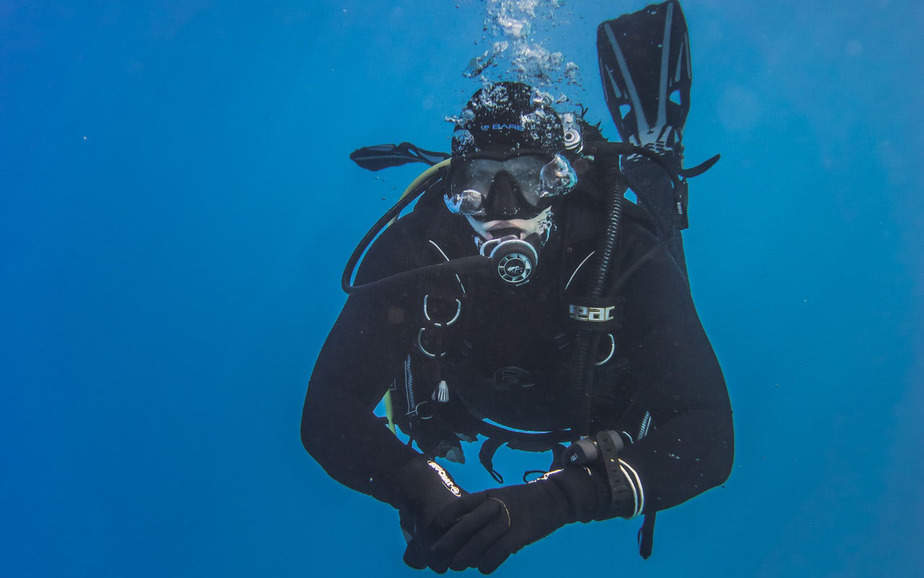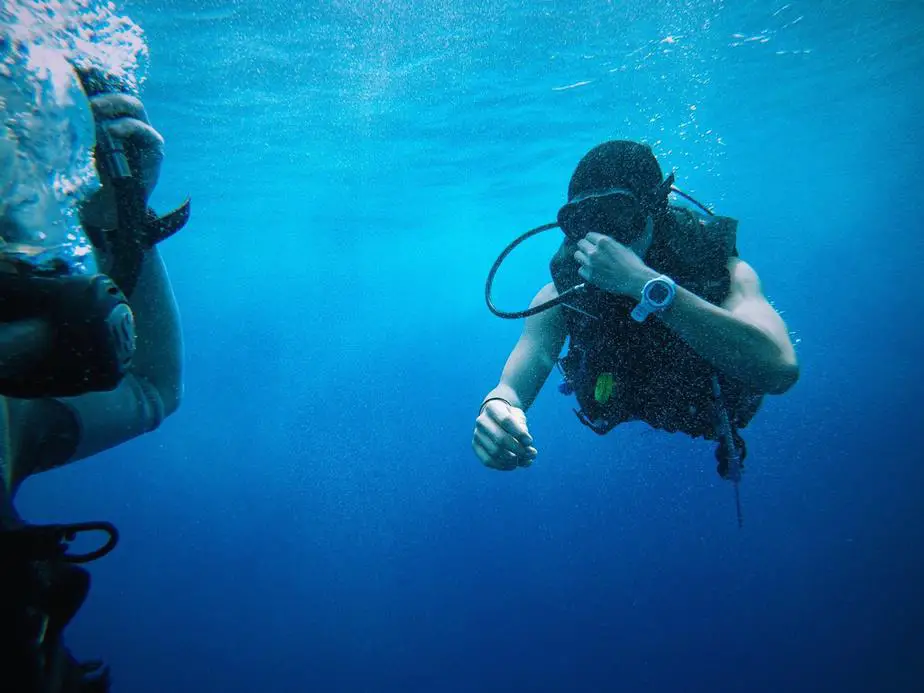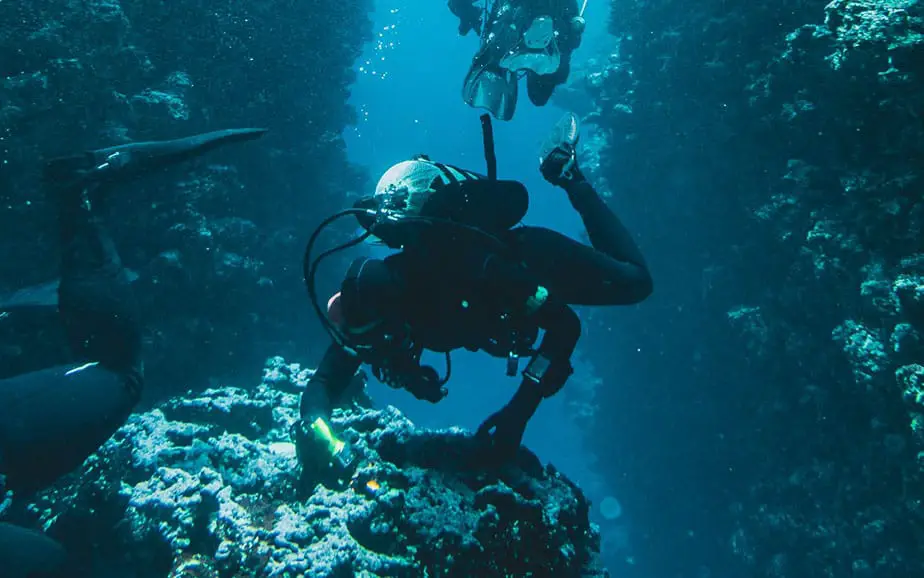Dive computers can be worn on the wrist (wrist-mounted) or console-mounted. There are pros and cons to each style and there is no right or wrong choice. As with many comparisons, the right answer depends on your diving needs and personal preferences. At the end of the day, both types are capable of providing you the necessary dive information, such as current depth, bottom time, NDL, and much more while underwater.
With that said, there is one clear advantage of the wrist dive computer which is that it’s highly versatile. Improvements in technology have allowed dive computers to get smaller and smaller. Nowadays, you can even get a watch dive computer that is indistinguishable from a digital watch. If your wrist dive computer is small and stylish enough, there’s no reason why you couldn’t wear it outside of diving as your daily watch.
However, if we’re doing an apples-to-apples comparison by talking solely about how wrist and console dive computers benefits scuba divers, then console computers will stand on more even footing. In this article, we’ll cover the pros, cons, similarities, and differences of console vs. wrist-mounted dive computers to help you decide which one is right for you.
What you should know about console dive computers
Is this your first time buying a dive computer? Then you should know that while there are some differences in design between console vs. wrist dive computers, in terms of tracking and providing dive data, both types of dive computers work similarly.
The biggest difference between the two types of dive computers is where they are mounted. For this reason, there is a big divide in what divers prefer to use. Some divers prefer the console versions because they feel the larger screen is more convenient to read underwater. This is useful for checking important metrics like current depth, dive time, and remaining dive time.
You don’t want to spend lots of time looking at a screen or to misread information, so being able to parse all of the information from a large screen with just a quick glance is a major benefit. That’s not to say that wrist dive computers can’t have large screens, however. A dive computer console is also a traditional option for divers, which is why many divers prefer them.
Tradition aside, there are some legitimate advantages that console dive computers have, which are:
Visibility
Divers like how console computers have a larger screen. When you are diving in murky water or at night, then it can be challenging to see what’s displayed on the screen. With a larger screen, the text size, icons, and graphs can be larger. Furthermore, more information can be displayed on one screen so you don’t have to navigate multiple screens to get the big picture.
However, just because a screen is larger doesn’t mean it’s easier to read. A very important factor for visibility is how bright the screen is. You can adjust the brightness settings to help you conserve precious battery if you don’t need it to be at max brightness. Larger screens also increase the viewing angle and reduce the effects of glaring or smudging.
Cost
Most console dive computers are cheaper than their wrist-mounted counterparts. Wrist models are more compact which requires more precise engineering, making them more expensive. Since console dive computers were around for longer, it’s also likely that manufacturers simply have a better process to manufacture console dive computers at a lower cost. If you’re on a tight budget, look for a console dive computer instead.
Convenience
Not a fan of having equipment hanging on your wrist? A console dive computer is generally attached to other scuba equipment such as your regulator. Even if the dive computer were to drop out of your hand, it won’t end up on the bottom of the ocean since it’s connected to something. You’re also less likely to forget bringing it with you since you’d be missing other essential gear that it’s attached to, such as the SPG.
A console dive computer is the best option for cold water diving where you will be wearing thick dive gloves. Trying to press a smaller wrist-mounted dive computer with thick gloves on is challenging with clumsy fingers. The buttons and switches on a console dive computer are easier to press no matter what type of water you’re diving in.
What you should know about wrist dive computers

Next, wrist dive computers are a more modern option than console dive computers. For its design, it looks highly reminiscent of a watch, except its watch face is necessarily larger so that you can read the display. Depending on which brand and model you go with, you can find circular or rectangular displays with a diameter of 2 inches to as large as 5 inches or more.
The information tracked and displayed on a wrist dive computer is the same as a console computer, like your bearing and remaining dive time. The easiest way to imagine a wrist dive computer is to think of a console dive computer packaged into a wristwatch. Some of the higher end models have useful features like Bluetooth connectivity to transfer data to and from another Bluetooth-capable device.
Here are the main reasons why some divers prefer a wrist dive computer over a console:
Portability
Some divers prefer wearing a wrist dive computer because it’s smaller, more stylish, and they prefer to read the data from their wrist. Having a smaller size makes it harder to read the display, but it keeps drag to a minimum and is easier to pack in your luggage while traveling. During the short period on the boat before the dive, or if you will be diving from shore, the lighter weight of the wrist dive computer reduces the burden until you’re in the water. If you don’t like the bulk of the console computer, you’ll love how sleek a wrist dive computer is.
Style
For a wrist dive computer, style is an important consideration. While style may not be much of a concern underwater compared to performance, the beauty of wrist dive computers is that they can be worn out of the water.
Wrist dive computers are often designed to look like a regular wristwatch, albeit with a bigger watch face, so that you can really get your money’s worth by using it on land too. These types of dive computers are known as watch dive computers, and they will come with watch modes like timer, alarm, 24-hour clock, multiple time zones, and more.
Even if you don’t care much for style, you can think of it as a bonus benefit.
Convenience
Although wrist dive computers have a smaller screen, some divers are willing to make the trade-off for convenience. Its sleek profile is more hydrodynamic which improves underwater performance.
Many people also like how convenient it is to see their data just by turning their wrist up instead of pulling out a hefty console computer every time they want to check their stats. Female divers tend to prefer wrist computers since bulky gear is hard to manage, especially above water.
Since the display is small, screen real estate becomes more important than ever, and the option to customize what’s on the main page is crucial. You can decide for yourself what you want to see first thing, and what should be relegated to a secondary page. Furthermore, the watch-like design and button placement is highly reminiscent of a digital watch which many people are already familiar with.
How the console and wrist dive computers came to be

At this point, it should be pretty easy to distinguish between these two types of computers. Wrist dive computers are worn on your wrist. A console-mounted dive computer means that the computer is attached to a console. There will be a second precision measuring instrument such as a compass or pressure gauge that’s part of the console.
Before dive computers were invented, divers needed to bring a plethora of gauges and instruments to track all of the data needed to help them make informed decisions. Many of these instruments were strapped to the forearm which occupied a lot of space. They wanted to free up arm space, and thus the first console dive computer was eventually made.
The first instruments which were combined with the console were the pressure gauges. They connected to the regulator’s first stage with a hose to measure the remaining pressure in the tank. With the advent of the dive computer, the depth gauge and bottom timer functionality could be found in it, though divers sometimes still keep these gauges around for redundancy.
With the dive computer fulfilling the function of so many gauges and instruments, it freed up space on the forearm and suddenly there was room for the dive computer to be worn on the wrist like a watch.
Today, you can have a dive computer as either part of a console or on your wrist. Let’s look at what advantages and disadvantages these two mounting options have.
Console vs. Wrist-Mounted – Pros and Cons

Whether you’re using a console or wrist-mounted dive computer, the core functionality of the device should be the same regardless of how it’s mounted. To confuse divers even more, often a dive computer will come in wrist-mounted or console-mounted versions. Whatever you choose, the major difference is in how it’s mounted; the specs and capabilities should be the same.
Console mounted dive computers have the second instrument (compass or SPG) as part of the console, so all the core dive tracking equipment is in one place. You may be able to add another gauge or instrument so you can get a view of all the dive data when looking at the console.
A wrist-mounted dive computer can have a built-in compass and wireless air integration features, however these are premium features that cost a lot of money. Specifically the air integration which requires purchasing a transmitter for each tank. Due to the smaller display, you most likely need to navigate through several screens to see all of the data. On a console, everything is in one view because all of the instruments are together.
When you need to travel by air to your dive location, it’s really easy to forget to pack in your wrist-mounted dive computer at home. This happens surprisingly often. A console-mounted dive computer attached to the console where the gauges are located as well, so it’s unlikely you’ll forget something this important.
Furthermore, console dive computers are tethered to the diver and difficult to lose while diving. While it’s also unlikely that a wrist dive computer will get lost, there are rare circumstances where the strap can come loose and you lose the wrist dive computer to the depths of the ocean.
Unfortunately, console dive computers are big. The size of a wrist dive computer with a standalone pressure gauge is smaller than a console. The bulkiness can be very annoying when traveling and its hydrodynamics are not very good, which is why many divers prefer wrist-mounted dive computers. It’s also more convenient to find the dive information on your wrist than fumbling to get to the console just to check some quick measurements.
There are some rare circumstances where a wrist-mounted dive computer may be safer to wear. For instance, dive instructors may find it easier to look at their wrist for data while pulling one of their students with them in an emergency. The same can be said for a situation where you might need to rescue a dive buddy. It’d be a lot harder to do that with a console. The chances of this happening are slim, but it’s something to think about.
Lastly, there is also a slim chance that the console tether gets tangled up in something underwater, which could trap the diver. However, a console that has been properly stowed and attached is unlikely to get entangled.
Which should you pick?
Still unsure of which mounting style you prefer? Ultimately it comes down to usability. As long as you know where your instruments are and how to quickly reach them when you need, it doesn’t really matter which type you go with. Maybe flip a coin, get used to whatever style you picked out, and live happily ever after.
If you want the most versatility, get a dive computer that lets you switch from a console-mount to a wrist-mount so you can give both options a try. You can also try renting dive computers in both styles and use them for a few dives to see which one feels more natural for you. When comparing a console-mounted dive computer vs. wrist-mounted, the deciding factor really can be as simple as preferring to have the dive computer on your wrist or not.


